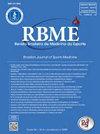PILATES VS AEROBIC TRAINING EFFECTS IN HYPERTENSIVES: RANDOMIZED TRIAL
4区 医学
Q4 Health Professions
Revista Brasileira de Medicina do Esporte
Pub Date : 2024-01-01
DOI:10.1590/1517-8692202430012021_0327i
引用次数: 0
Abstract
ABSTRACT Introduction: The Pilates method (PM) combines slow-deep breathing with strengthening and stretching exercises. However, it has been proposed as a method of physical conditioning for several decades and only recently aroused academic/scientific interest, with few reports of the effects of this intervention in hypertensive patients. Objective: to compare PM to aerobic training (AT) effects on hypertensive subjects’ blood pressure (BP), functional capacity and autonomic balance. Methods: Twenty-four hypertensive subjects were randomly allocated into two groups: ATG performed three 40 min sessions/week, moderate intensity (40-70% of reserve HR), and PMG performed two 60 min sessions/week; both during the same eight weeks period. Blood pressure (casual and for 24 hours), 6-minute walking test (6-MWT) and autonomic balance were evaluated before and after intervention. Results: There was a reduction on systolic BP (SBP, p=0.007), diastolic (p=0.032) and mean blood pressure (MBP, p=0.016), measured on 24h, on PMG. There was also a 24h SBP reduction on ATG (p=0.021). The PMG had a greater reduction on 24h SBP (-3.4 mmHg, 95% CI -6.6 to -0.2) and MBP (-3.3 mmHg, 95% CI -6.3 to -0.3) than the ATG. ATG held a longer distance in 6-MWT. Casual BP and autonomic balance had no difference. Conclusion: This PM protocol was superior to AT on BP monitored for 24 hours in hypertensive subjects, but AT was better for functional capacity. The eight weeks of training were not enough to change the autonomic balance. Level of Evidence: I; High-quality randomized clinical trial with or without statistically significant difference, but with narrow confidence intervals.普拉提与有氧训练对高血压的影响:随机试验
摘要简介:普拉提法(PM)将缓慢的深呼吸与强化和伸展运动相结合。然而,它作为一种身体调节方法已经被提出了几十年,直到最近才引起学术/科学的兴趣,很少有关于这种干预对高血压患者影响的报道。目的:比较有氧训练(AT)和PM对高血压患者血压(BP)、功能能力和自主神经平衡的影响。方法:24例高血压患者随机分为两组:ATG组进行3次40分钟/周,中等强度(储备心率40-70%),PMG组进行2次60分钟/周;都是在同样的八周时间里。在干预前后评估血压(随意和24小时)、6分钟步行测试(6-MWT)和自主平衡。结果:PMG治疗后24h收缩压(SBP, p=0.007)、舒张压(p=0.032)和平均血压(MBP, p=0.016)均有降低。ATG组24h收缩压降低(p=0.021)。与ATG相比,PMG具有更大的24h收缩压(-3.4 mmHg, 95% CI -6.6 ~ -0.2)和MBP (-3.3 mmHg, 95% CI -6.3 ~ -0.3)的降低。ATG在6-MWT中保持了更长的距离。随意血压和自主平衡无差异。结论:PM方案在高血压患者24小时血压监测上优于AT方案,但AT方案在功能容量监测上优于AT方案。8周的训练不足以改变自主神经平衡。证据等级:一级;高质量随机临床试验,有无统计学显著差异,但置信区间窄。
本文章由计算机程序翻译,如有差异,请以英文原文为准。
求助全文
约1分钟内获得全文
求助全文
来源期刊

Revista Brasileira de Medicina do Esporte
PHYSIOLOGY-SPORT SCIENCES
自引率
0.00%
发文量
204
审稿时长
6-12 weeks
期刊介绍:
The Revista Brasileira de Medicina do Esporte (RBME in its Portuguese form) is an official organ of the Sociedade Brasileira de Medicina do Exercício e do Esporte (SBME) Brazilian Society of Exercise Medicine and Sports) and represents the main promotion resource of the scientific production in the Exercise Sciences and Sports Medicine (SBME) fields in our country. The RBME was launched in 1995 with trimester periodicity and became regularly bi-monthly published with no interruptions from 1999.
RBME is an inter-and multidisciplinary, peer reviewed, Open Access journal which accepts contributions from the national and international scientific community. RBME publishes original articles of high scientific relevance in Exercise and Sports Medicine, review articles, and systematic reviews.
RBME preferably publishes original articles of international interest, not only of regional significance. Its goal is to disseminate the scientific production in the areas of exercise and sports medicine through the publication of original research results and other documents that contribute to the scientific and applied knowlewdge of physical activity, exercise and sports, within the framework of biological sciences and medicina.
Its title abbreviation is Rev Bras Med Esporte, which should be used in references, footnotes and reference subtitles.
 求助内容:
求助内容: 应助结果提醒方式:
应助结果提醒方式:


